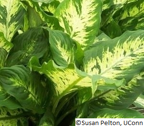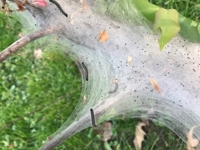Annuals & Perennials
- Cut ornamental grasses back to a height of 6 inches before new growth appears.
- Cut buddleia, Russian sage, and Montauk daisies to a height of 8-12 inches.
- Prune lavender to 1/3 of its height once new growth appears.
- Prune old, leggy growth from heather (which flowers on new growth in late summer) but prune heath (which sets its flower buds in late spring) just enough to shape it in the early spring.
- Pull back mulch from perennials to allow the soil to warm up but be prepared to temporarily cover them if heavy frosts are predicted.
- Start dahlia tubers in pots indoors in a cool, bright spot. Cover tuberous roots with 2 to 3 inches of potting mix. Pinch back tips when they reach 6 inches and transplant outdoors when the ground temperature reaches 60° F..
- Get the jump on weeds in garden beds by pulling out any that overwinter and applying mulch.
- For an instant spring show, fill containers with purchased forced spring bulbs from supermarkets and garden centers.
- Freezing temperatures don’t harm pansies, but if they have been grown in a greenhouse they should be gradually exposed to outdoor temperatures before planting.
- Keep Easter lilies in a moist and brightly lit location. They can be planted in the garden after the danger of frost.
- Divide overcrowded summer or fall blooming perennials.
- Hardy water lilies may be planted in pools in spring but wait until the water reaches 70° for tropical water lilies.
- Place peony supports.
Houseplants

- Transplant houseplants that need repotting.
- Inspect houseplants for pests and use low-toxicity insecticidal controls as needed.
- Cut back plants that have grown leggy.
Vegetable Gardening

- Weather permitting, direct sow peas, carrots, radishes, lettuces, and spinach every two weeks through mid-May for staggered harvests.
- Plant seedlings of cauliflower, cabbage, and broccoli once weather settles..
- Purchase onion sets for planting and set 1 inch deep and 4 to 5 inches apart when soil can be worked.
- Place seedlings in cold frames around April 25 or later to harden off.
Fruits
- Check fruit trees for Eastern tent caterpillars, they emerge around the same time as leaves sprout. Blast nests with a strong spray of water to destroy them.
- Spread fertilizer under apple trees and small fruitsexcept strawberries which are fertilized in late August.
- Continue to apply horticultural oil sprays to control insect pests on fruit trees if temperature is over 40°F.
- Don't wait too long to remove mulches from strawberries. Once the leaves have emerged from under the straw and yellowing is evident, pull the mulch away from the tops of the plants and tramp it down between the rows. Keeping the base of the plants mulched helps keep the berries clean, controls weeds, and conserves moisture.
Insects
- Apply sprays as needed to control insect pests and diseases on apple , peaches and nectarines, pear, and plum trees if the temperature is over 40°F.
- Check fruit trees for Eastern tent caterpillars, they emerge around the same time as leaves sprout. Blast nests with a strong spray of water to destroy them.
- A new generation of spongy moth caterpillars will hatch in late April and begin feeding on the leaves of many tree species. Remove and destroy any egg masses you find on your trees.
Lawns
- Dead spots in the lawn can still be renovated in early April. Top dress bare areas with a mix of topsoil and compost, reseed, and keep moist until germination.
- Apply pre-emergent crabgrass weed control when soil temperatures reach 50°F. Use a tool like this soil temperature map to track your timing.
- Do not use a pre-emergent weed control if you are trying to germinate grass seed.
- Early spring is a great time to spot spray or hand-dig dandelions. If spraying, choose a product that won’t kill grass. If digging, wait until after a rain, when soil is soft.
- Prune back bedraggled looking ground covers and fertilize lightly after April 15.
Trees & Shrubs

- A new generation of spongy moth and eastern tent caterpillars will hatch in late April and begin feeding on the leaves of many tree species. Remove and destroy any egg masses you find on your trees.
- Spongy moth egg masses are buff-colored and may be found on trees, stones, fences, lawn furniture, and other protected places.
- The eggs of the eastern tent caterpillar are deposited in brownish masses, resembling a large raisin squeezed around a twig. Scrape off the egg masses and crush underfoot or drop into a pail of detergent and water.
- Complete removal of diseased, weak, or crossing branches on shrubs and small trees.
- Celebrate Arbor Day by planting a tree. Choose planting sites based on exposure to sun, shade, wind and distance from water source.
- Remove any remaining leaves from last summer on roses and spread a thin layer of new mulch underneath them. This will help prevent the spread of any diseases that may have over-wintered.
- Spread fertilizer under apple trees as buds swell and open.
Wildlife

- Check for raised mole tunnels in the yard and plan to put down a grub control product as necessary (the presence of moles does not mean there is a grub problem) between mid-June and mid-July.
- Set up a bat house early in the month to encourage them to roost. Visit the DEEP’s Bats fact sheet for information and bat house plans.
Yard Accessories & Miscellanea
- Set up 1 or 2 rain barrels at downspouts to water garden beds, flower beds, and containers.
Resources
Soil Temperature Map
Many pesticides, fertilizers, and seeds need an optimum soil temperature to be the most effective. Take out the guess work by tracking conditions in your zip code!
Hummingbird Migration Tracker
Watch the hummingbird migration to help you determine the best time to put out your feeders!
Connecticut Native Plants
UConn Extension and CT DEEP Wildlife Division have released an updated list of CT native plant selections and businesses that grow and/or sell these plants! See below for the updated list for 2025. One of the biggest updates is that the list now also includes native perennials!
Despite good cultural practices, pests and diseases at times may appear. Chemical control should be used only after all other methods have failed. For pesticide information please call UConn Home and Garden Education Center weekdays, in Connecticut call toll free 877-486-6271. Out of state call 860-486-6271
Revised by the UConn Home and Garden Education Center 2024
Issued in furtherance of Cooperative Extension work, Acts of May 8 and June 30, 1914, in cooperation with the U.S. Department of Agriculture, the Dean of the College, Cooperative Extension System, University of Connecticut, Storrs. The Connecticut Cooperative Extension System is an equal opportunity employer and program provider. To file a complaint of discrimination, write USDA, Director, Office of Civil Rights, Room 326-W, Whitten Building, Stop Code 9410, 1400 Independence Avenue, SW, Washington, DC 20250-9410 or call (202) 720-5964.